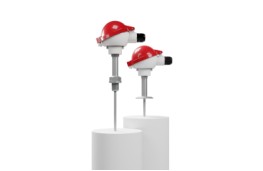Temperature measurement is a fundamental aspect of various industries and everyday life. From weather forecasting and industrial processes to household appliances and medical devices, temperature sensors play a crucial role in providing accurate data for making informed decisions. But how does a temperature sensor work? In this article, we will delve into the mechanisms behind temperature sensors and explore the principles that enable them to measure temperature accurately.
A temperature sensor, as the name suggests, is a device designed to measure temperature. It detects changes in temperature and converts this physical parameter into an electrical signal that can be easily interpreted and displayed.

Temperature sensors rely on the principle that certain physical properties of materials change with temperature. These properties include:
Resistance: Some materials exhibit changes in electrical resistance with temperature, known as the temperature coefficient of resistance (TCR).
Voltage: Certain semiconductors generate a voltage that varies with temperature, known as the voltage-temperature relationship.
Electromotive Force (EMF): Thermocouples generate an electromotive force when exposed to a temperature gradient.
Infrared Radiation: Infrared temperature sensors detect the radiation emitted by an object, which is proportional to its temperature.
There are several types of temperature sensors, each utilizing different principles to measure temperature accurately. Some common types include:
Thermocouples are among the most widely used temperature sensors due to their robustness and wide temperature range. They consist of two different metal wires connected at one end, forming a junction. The temperature difference between the junction and the open ends generates a voltage, which can be measured to determine the temperature.
RTDs use the principle of changes in electrical resistance with temperature. They are made of pure metals, such as platinum, and their resistance increases linearly with temperature. The change in resistance is used to calculate the temperature accurately.
Thermistors are temperature-sensitive resistors made from semiconductor materials. Their resistance varies significantly with temperature, making them suitable for precise temperature measurements in a limited range.
Infrared temperature sensors measure the infrared radiation emitted by an object and convert it into temperature readings. They are non-contact sensors, making them ideal for measuring the temperature of objects that are difficult to access or hazardous to touch.
Resistance-based temperature sensors work on the principle of measuring changes in electrical resistance. When the sensor is exposed to temperature changes, its resistance changes accordingly. This change in resistance is converted into an electrical signal that can be measured and calibrated to determine the temperature accurately.
Thermocouples work based on the Seebeck effect. When two dissimilar metals are joined at one end, a voltage is generated when there is a temperature gradient between the junction and the open ends. This voltage is proportional to the temperature difference and can be used to calculate the temperature accurately.
Infrared temperature sensors use a lens to focus the infrared radiation emitted by an object onto a detector. The detector then converts the radiation into an electrical signal, which is translated into temperature readings. As these sensors measure infrared radiation, they can provide non-contact temperature measurements.
Temperature sensors find applications in various fields, including:
Weather Forecasting: Weather stations use temperature sensors to monitor and predict weather conditions.
Industrial Processes: Temperature sensors are crucial for controlling and maintaining temperature-sensitive industrial processes.
Household Appliances: Temperature sensors are used in refrigerators, ovens, and air conditioners to regulate temperature.
Healthcare: Medical devices use temperature sensors for monitoring body temperature and controlling incubators.
Temperature sensors are vital tools in numerous applications, providing accurate temperature data for diverse industries and everyday use. By understanding the principles behind temperature measurement and the various sensor types, we can appreciate the significance of these devices in our modern world. From ensuring optimal industrial processes to enabling comfortable living environments and aiding in medical diagnostics, temperature sensors have become indispensable components in our lives.